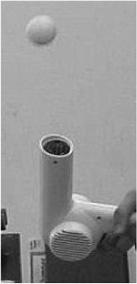125 Physics Projects for the Evil Genius (27 page)
Read 125 Physics Projects for the Evil Genius Online
Authors: Jerry Silver

This project works because of the volume differences between vapor and liquid, and the force exerted by air pressure.
Blowing up a marshmallow. Less is s’more. Why astronauts do not use shaving cream in space
.
The next time you are sitting around the campfire cooking up a batch of s’mores, be sure to point out to your friends that a marshmallow is simply a colloidal suspension of air in a solid. Because the air in the marshmallow is in equilibrium with the atmosphere, the volume of the marshmallow is stable at standard air pressure. However, it’s a different story if we disturb the equilibrium conditions by taking away the atmospheric pressure.
- marshmallow
- bell jar
- vacuum pump
- Place a marshmallow on the base of the bell jar.
- Assemble the bell jar and apply a vacuum.
- Observe what happens.
The marshmallow grows in volume, as you can see in
Figure 41-1
.
The pressure of the air trapped in each marshmallow causes the marshmallow to expand when the pressure outside the marshmallow is reduced.
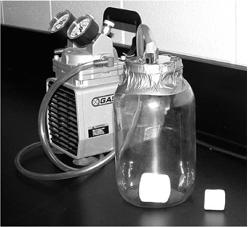
Figure 41-1
Air pressure trapped in a marshmallow causes expansion of the marshmallow. (The vacuum jar pictured here was adapted from an apparatus used to show the dropoff in sound transmission as air pressure is reduced
.)
Try this with shaving cream. It will increase in volume.
Try this with hot water, just under the boiling point. The water should begin to boil again.
Common objects depend on air pressure for them to maintain their physical shape and appearance.
Relaxing on a bed of nails
.
Would you sit down on a bunch of nails that are sticking out of a wooden board with the sharp pointy sides upward? This is your chance to try. This is not nearly as painful as it may seem because the large number of nails spreads the force over a larger area.
- 144 nails, 1½ to 2 inches long. Whatever length you use, make sure the nails are nearly all the same length
- piece of plywood 14 inches × 14 inches × ¾ inches thick (or larger)
- electric drill
- drill bit whose diameter is equal to or just slightly smaller than the diameter of the nails
- inflated balloon
- Draw evenly spaced lines at 1-inch intervals running parallel with each of the edges of the board.
- Drill a hole at the intersection of each of the holes.
- Insert the nails in the holes. They should be snug enough not to fall out. Some may have to be driven in with a hammer (
Figure 42-1
).
- Press the balloon on one of the nails on the corner.
- Press (another) balloon in the center of the bed (
Figure 42-2
). - Place the nails on a chair and sit down on it.
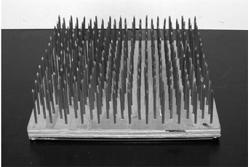
Figure 42-1
Bed of nails
.

Figure 42-2
The force is spread out over a large number of nails
.
With one nail isolated, the balloon will burst. However, with several nails in contact with the balloon, the balloon does not burst, even with substantial pressure applied. Sitting on the bed of nails is surprisingly painless.
Pressure
is force divided by area. For a given force pressing down on the balloon, the pressure is much greater with the single nail than with the large group of nails. When you sit on the group of nails, the force is the result of your weight, but the pressure is spread out over the large number of nails.
Razor blades that use multiple blades apply the principle of spreading out the force exerted by any one blade over a large surface area.
Instead of just a seat, why not build a nice comfortable bed to sleep on?
You can also show how pressure can be spread out over a larger area by using several cups to support a person. Set up a board on a row of paper cups, as shown in
Figure 42-3
. Then, have a person stand on the board. If you have enough cups, you should be able to stand on the board supported by the paper cups. Some cups are stronger than others, so you may have to experiment to determine how many you need. Placing them every 2 inches or so, however, is a good place to start.
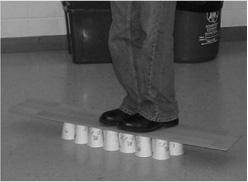
Figure 42-3
The person’s weight is distributed over several cups
.
Pressure
is force divided by area. The larger the area a force is applied over, the smaller the pressure experienced.
Blowing hanging cans apart. What Bernoulli had to say about this
.
Here is a simple challenge: hang two empty soda cans from a string, separated by a few inches, and then blow them apart. Whether you use your lungs or a hair dryer, the result will be the same.
- 2 empty soda cans
- 2 strings
- blow dryer
- Attach the strings to the can and hang from a support (such as a ring stand).
- With the blow dryer (or your own breath if you are good at blowing out birthday candles), direct a stream of air between the cans. Avoid blowing so hard that the cans start bouncing around, which will only serve to confuse the issue.
- Observe what happens (
Figure 43-1
).
Instead of blowing the cans apart, the air stream will drive them together. In fact, the harder you blow, the greater the force that moves the cans together.
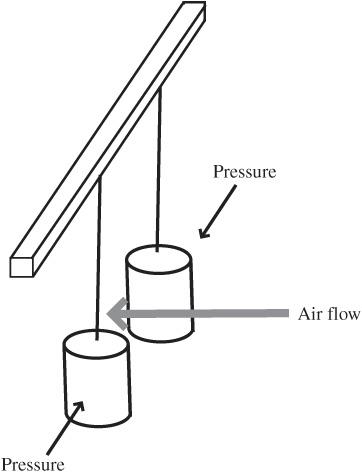
Figure 43-1
Greater air velocity results in lower pressure to draw can together
.
What is going on here was explained by Bernoulli. A key consequence of the principle that bears his name is the faster air moves, the lower the air pressure. This is the mechanism for airplane lift. The contour of the airplane wing directs air above the wing at a higher velocity, resulting in a lower pressure above the wing. A spoiler on a race car does the same thing, but upside down. A sailboat takes advantage of
Bernoulli’s principle by directing the air in front of the sail at a higher velocity. This produces a greater force on the wing and enables the sailboat to move at a greater velocity than the wind driving it.
A stream of moving air from a blow dryer keeps an object, such as a ping-pong ball, suspended in mid air. See
Figure 43-2
. This is another example of Bernoulli’s principle. The faster moving air in the center results in a pressure gradient that draws the ball into the air steam above the blow dryer.
Another way to explore Bernoulli’s principle is to take a sheet of paper and hold it horizontally in front of your mouth. The paper will droop down in front of you. Blowing across the top of the paper will reduce the pressure above the paper, causing it to defy gravity and straighten out horizontally.
If you place a dowel in the center of a roll of toilet paper and direct a blow dryer across the top, you can run out the entire roll! If anyone complains about the mess, just say you had to do it to prove Bernoulli’s principle. (Then, of course, please clean up the mess.)
